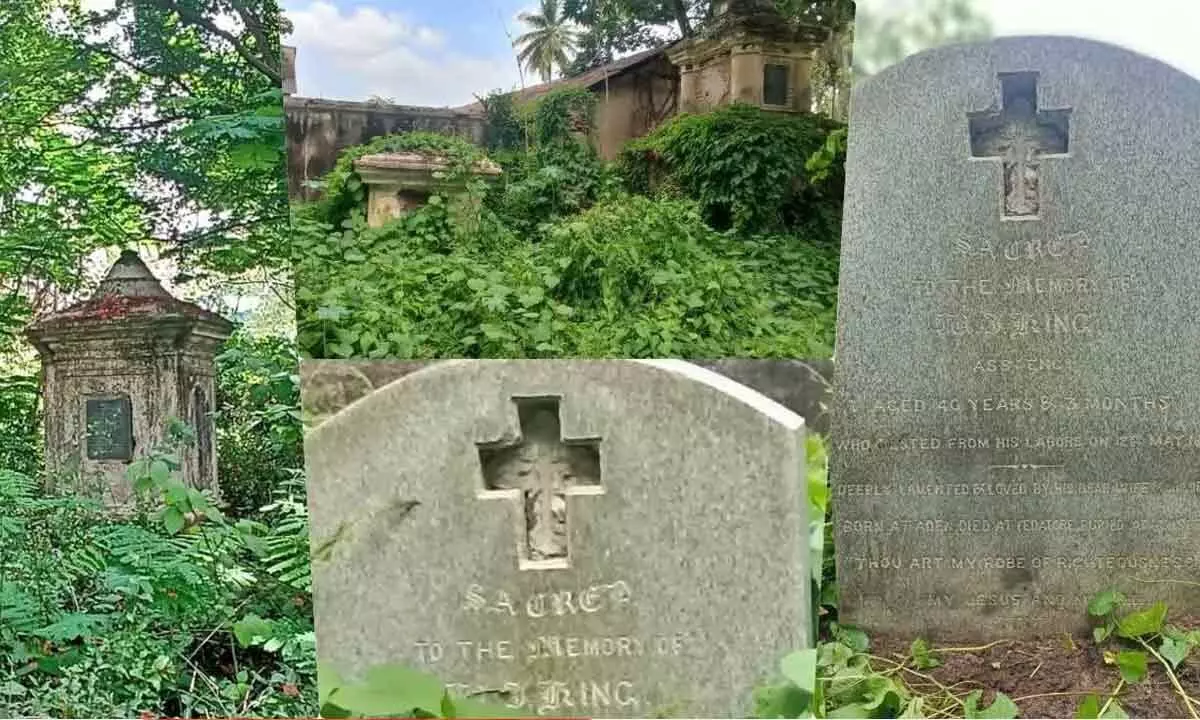250-yr-old dilapidated tombs of British era piques public interest

250-yr-old dilapidated tombs of British era piques public interest
These tombs can be found if one walks a little further along the old post office road near Brahminara Street in Hunsur. These are not immediately visible as trees cover the tombstones. Even the locals have no proper information about these tombs present for centuries
Mysuru: Although the British have ruled entire country for more than two centuries. Even today, many traces can be found. Similarly, 250-year-old tombs have come to light in Mysuru , which has evoked a surprise.
There are some dilapidated graves of the British beside the river Lakshmana Tirtha in Hunsur taluk. At first sight they cannot be called tombs. The towers of the old temple seem to be there. The British graves bring memories of history to the eye only if you go closer. If you go to see the graves here, the bushes are covered and there is a lot of mosquitoes. Bad smell also hits the nose.
It is surprising that the graves of the British era did not seen by locals or they just ignored. The British graves, which have been lying dormant for nearly 250 years, are now piquing public interest. Next to this tombs there is Vasavi Goshala and Vasavi Vana Prastashram. These tombs can be seen if you walk a little further along the old post office road near Brahminara Street. But these cannot be seen very closely for now. Entire trees cover the tombstones and can be seen from a distance. Even the locals have no proper information about these tombs for centuries. There is a doubt that these may be the tombs of British high authorities as the area was ruled by Britishes. While some tombs are flat in shape, some tombs are circular and in the shape of towers. A couple of tombs have withstood centuries of rain and sun and are somewhat safe. According to some locals, they are the graves of some British who were the owners of coffee plantations in Kodagu. In some graves, there are details such as the name, age, gender and cause of death. The age of the deceased is also entered on the tomb: if the age of the deceased is 29, then it is 53 in some tombs. A closer look at the graves can tell that the dead are likely to be children of husband and wife of the same family. It can be noticed that in some tombs the exact age, month and days of the deceased have been clearly mentioned. It is very interesting that there are details about the two buried in one grave. There are possibilities that father and son are buried here. Today most of these British tombs have reached a state of disrepair. In some places, the tombstones are shaking due to soil erosion over the centuries. Today there is no trace of the compound that was built then. There is no doubt that this is a cemetery that was limited only to the British, if we observe that there are graves of all on one side. Some tombs are rich in art. Some other graves are very common. But there are sad and sentimental lines on all the tombs. There is the pain of those who have lost themselves. Currently there are no direct access to these tombs. Even though the British ruled us, historically such places hold great significance. These are preserved by the local people and the Department of archeaology. According to local people, Hunsur Coffeeworks was established around 1800 . The locals are strongly of the opinion that it may be the tombs of the head of the coffeeworks and their relatives. Talking to this reporter Dr. DC Nanjunda, assistant professor of Mysore university said, There is information that more than 3000 workers were working there from different places. It can be noticed that the English machines are still present in Hunsur Coffeeworks. We who are preserving Mughal tombs should also pay attention to the preservation of these tombs.
He said Information in this regard should be forwarded to the British Embassy. The archaeological department needs to clean the place completely and put a compound around it. Dr. Mahadeva, a resident of Nallurupala village in Hunsur, said that there are more than 20 British tombs in this place, which should be preserved and its history and importance should be known to everyone. The fact that there are graves here has not been brought to light till today. They say that if a study is conducted and proper information is given, it will benefit the people.














